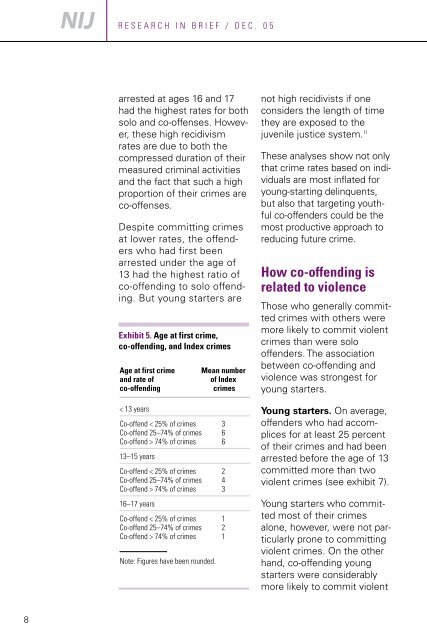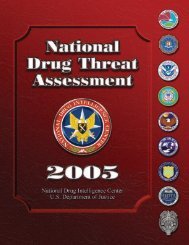Co-Offending and Patterns of Juvenile Crime - justice studies
Co-Offending and Patterns of Juvenile Crime - justice studies
Co-Offending and Patterns of Juvenile Crime - justice studies
You also want an ePaper? Increase the reach of your titles
YUMPU automatically turns print PDFs into web optimized ePapers that Google loves.
R E S E A R C H I N B R I E F / D E C . 0 5<br />
arrested at ages 16 <strong>and</strong> 17<br />
had the highest rates for both<br />
solo <strong>and</strong> co-<strong>of</strong>fenses. However,<br />
these high recidivism<br />
rates are due to both the<br />
compressed duration <strong>of</strong> their<br />
measured criminal activities<br />
<strong>and</strong> the fact that such a high<br />
proportion <strong>of</strong> their crimes are<br />
co-<strong>of</strong>fenses.<br />
Despite committing crimes<br />
at lower rates, the <strong>of</strong>fenders<br />
who had first been<br />
arrested under the age <strong>of</strong><br />
13 had the highest ratio <strong>of</strong><br />
co-<strong>of</strong>fending to solo <strong>of</strong>fending.<br />
But young starters are<br />
Exhibit 5. Age at first crime,<br />
co-<strong>of</strong>fending, <strong>and</strong> Index crimes<br />
Age at first crime<br />
<strong>and</strong> rate <strong>of</strong><br />
co-<strong>of</strong>fending<br />
Mean number<br />
<strong>of</strong> Index<br />
crimes<br />
not high recidivists if one<br />
considers the length <strong>of</strong> time<br />
they are exposed to the<br />
juvenile <strong>justice</strong> system. 11<br />
These analyses show not only<br />
that crime rates based on individuals<br />
are most inflated for<br />
young-starting delinquents,<br />
but also that targeting youthful<br />
co-<strong>of</strong>fenders could be the<br />
most productive approach to<br />
reducing future crime.<br />
How co-<strong>of</strong>fending is<br />
related to violence<br />
Those who generally committed<br />
crimes with others were<br />
more likely to commit violent<br />
crimes than were solo<br />
<strong>of</strong>fenders. The association<br />
between co-<strong>of</strong>fending <strong>and</strong><br />
violence was strongest for<br />
young starters.<br />
< 13 years Young starters. On average,<br />
<strong>Co</strong>-<strong>of</strong>fend < 25% <strong>of</strong> crimes 3 <strong>of</strong>fenders who had accom-<br />
<strong>Co</strong>-<strong>of</strong>fend 25–74% <strong>of</strong> crimes 6 plices for at least 25 percent<br />
<strong>Co</strong>-<strong>of</strong>fend > 74% <strong>of</strong> crimes 6<br />
<strong>of</strong> their crimes <strong>and</strong> had been<br />
13–15 years arrested before the age <strong>of</strong> 13<br />
<strong>Co</strong>-<strong>of</strong>fend < 25% <strong>of</strong> crimes 2 committed more than two<br />
<strong>Co</strong>-<strong>of</strong>fend 25–74% <strong>of</strong> crimes 4<br />
<strong>Co</strong>-<strong>of</strong>fend > 74% <strong>of</strong> crimes 3<br />
violent crimes (see exhibit 7).<br />
16–17 years Young starters who commit-<br />
<strong>Co</strong>-<strong>of</strong>fend < 25% <strong>of</strong> crimes 1 ted most <strong>of</strong> their crimes<br />
<strong>Co</strong>-<strong>of</strong>fend 25–74% <strong>of</strong> crimes 2 alone, however, were not particularly<br />
<strong>Co</strong>-<strong>of</strong>fend > 74% <strong>of</strong> crimes 1<br />
prone to committing<br />
Note: Figures have been rounded.<br />
violent crimes. On the other<br />
h<strong>and</strong>, co-<strong>of</strong>fending young<br />
starters were considerably<br />
more likely to commit violent<br />
8





